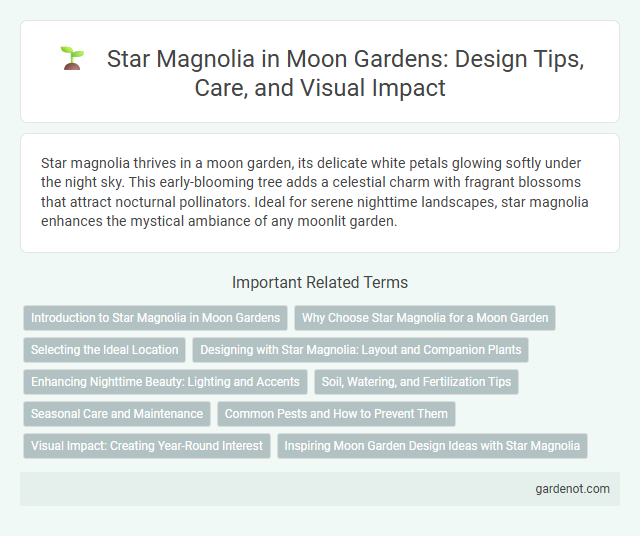Star magnolia thrives in a moon garden, its delicate white petals glowing softly under the night sky. This early-blooming tree adds a celestial charm with fragrant blossoms that attract nocturnal pollinators. Ideal for serene nighttime landscapes, star magnolia enhances the mystical ambiance of any moonlit garden.
Introduction to Star Magnolia in Moon Gardens
Star Magnolia (Magnolia stellata) is a prized ornamental tree in moon gardens, renowned for its early spring bloom of fragrant, star-shaped white flowers that glow under moonlight. This deciduous shrub thrives in well-drained soil and partial shade, making it ideal for creating a serene nighttime atmosphere. Its delicate blossoms and compact form enhance the mystical aesthetic and sensory experience characteristic of moon gardens.
Why Choose Star Magnolia for a Moon Garden
Star Magnolia (Magnolia stellata) thrives in moon gardens due to its striking, fragrant white flowers that bloom early in spring, creating a luminous nighttime display. Its compact size and delicate star-shaped petals reflect moonlight beautifully, enhancing the garden's ethereal ambiance. The shrub's low maintenance and adaptability to partial shade make it an ideal choice for serene, moonlit landscapes.
Selecting the Ideal Location
Star magnolia thrives in well-drained soil with full sun to partial shade, making it ideal for moon gardens that emphasize nighttime beauty. Planting it away from strong winds protects its delicate flowers, ensuring vibrant blooms in early spring. Positioning it near light-colored surfaces enhances its luminous petals, creating a striking focal point under moonlight.
Designing with Star Magnolia: Layout and Companion Plants
Star Magnolia thrives in well-drained, slightly acidic soil with full sun to partial shade, making it a striking centerpiece for moon gardens due to its fragrant, cream-white star-shaped blossoms blooming in early spring. Pairing Star Magnolia with shade-tolerant, low-growing companions like hostas and ferns enhances the garden's layered texture while complementing its delicate flowers. Incorporate evergreen shrubs and groundcovers to maintain year-round interest and create a tranquil, reflective atmosphere under moonlight.
Enhancing Nighttime Beauty: Lighting and Accents
Star magnolia's delicate white blooms radiate an ethereal glow under strategically placed garden lighting, enhancing its nighttime beauty and creating a captivating focal point in moon gardens. Soft LED uplights and ground-level spotlights emphasize the flower's star-shaped petals, casting gentle shadows that add depth and texture to evening landscapes. Incorporating subtle accent lighting around the Star magnolia not only highlights its natural elegance but also transforms nighttime garden spaces into enchanting retreats.
Soil, Watering, and Fertilization Tips
Star magnolia thrives in well-drained, slightly acidic to neutral soil with a pH between 5.5 and 7.0, enriched by organic matter to enhance moisture retention and root health. Water consistently during the growing season, ensuring the soil remains moist but not waterlogged, with deeper watering encouraged to promote strong root development. Fertilize in early spring using a balanced, slow-release fertilizer rich in nitrogen, phosphorus, and potassium to support vigorous growth and abundant blooms throughout the season.
Seasonal Care and Maintenance
Star magnolia requires regular seasonal pruning during late winter to remove dead or damaged branches and to shape the plant for optimal blooms. Applying a balanced fertilizer in early spring promotes vigorous growth and abundant flowering. Consistent watering during dry spells ensures the tree maintains health and vibrant blossoms throughout the blooming season.
Common Pests and How to Prevent Them
Star magnolia (Magnolia stellata) is susceptible to common pests such as scale insects, aphids, and spider mites, which can cause leaf discoloration and reduced growth. To prevent infestations, maintain proper plant hygiene by removing fallen debris, apply insecticidal soap, and encourage beneficial insects like ladybugs. Regular monitoring and ensuring adequate watering and fertilization enhance the plant's resistance against these pests.
Visual Impact: Creating Year-Round Interest
Star magnolia delivers stunning visual impact with its early spring blossoms of pristine white flowers that brighten the Moon garden before most plants awake. Throughout the year, its glossy green leaves shift to a subtle bronze in fall, providing seasonal color variation. This evergreen presence combined with dramatic floral display ensures continuous aesthetic appeal in landscape design.
Inspiring Moon Garden Design Ideas with Star Magnolia
Star Magnolia (Magnolia stellata) adds delicate, star-shaped white or pink blossoms that elevate the ethereal beauty of a Moon Garden, thriving in partial shade with well-drained soil to achieve optimal bloom. Its early spring flowering period complements the lunar-inspired theme by creating a soft, luminous contrast against night-blooming plants like white hydrangeas or fragrant moonflowers. Integrating Star Magnolia near pathways or water features enhances the tranquil ambiance, making it a focal point for serene evening strolls under moonlight.
Star magnolia Infographic

 gardenot.com
gardenot.com